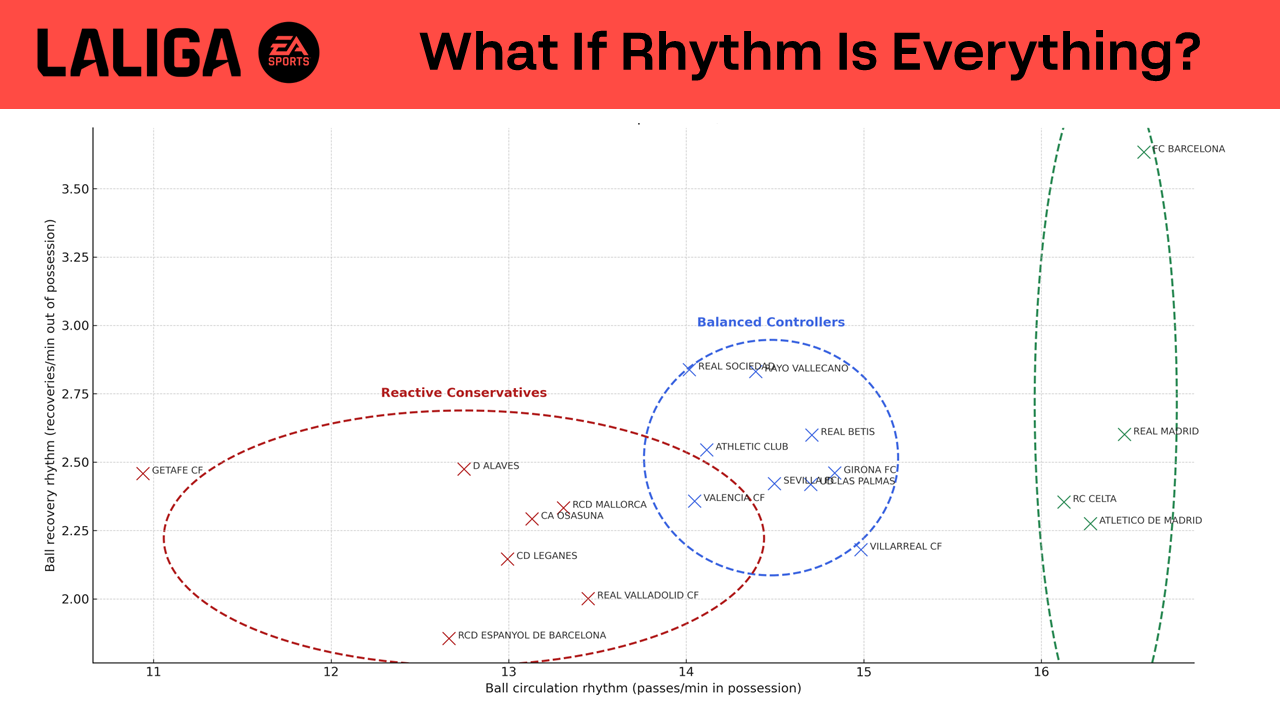
23 Jun What If Rhythm Is Everything? How Ball Circulation and Recovery Speed Explain Success in LALIGA

What If Rhythm Is Everything? How Ball Circulation and Recovery Speed Explain Success in LALIGA
Do you really control the match, or do you just keep the ball?
Do your players move it with rhythm and purpose, or simply maintain possession?
Does your team recover with structure, or react without intent?
These are not theoretical questions—they are tactical reflections. And thanks to an in-depth study from the Football Intelligence Department of LALIGA, using full-season data from Mediacoach (2024/25), we now have measurable answers.
This analysis focused on two key metrics:
- Ball circulation rhythm: passes per minute in possession
- Ball recovery rhythm: recoveries per minute out of possession
And what we found is that these rhythms strongly correlate with success.
Key Findings
Across the entire LALIGA EA Sports 2024/25 season:
- In 64.2% of matches, the team with the highest ball circulation rhythm did not lose.
- In 65.3% of matches, the team with the highest recovery rhythm did not lose.
- When a team dominated both rhythms, the percentage rose to 66.0%.
That means rhythm is not just about style. It’s about results.
Three Distinct Rhythm Profiles in LALIGA
By clustering teams based on their circulation and recovery rhythms, we identified three tactical models:
? Cluster 3 – Total Dominators
Teams: FC Barcelona, Real Madrid, Atlético de Madrid, RC Celta
Average points per match: 1.99
High tempo in both phases. These teams move the ball with speed and recover it with structure and intensity. Unsurprisingly, the top three teams in the league are found here. It’s not anecdotal. It’s measurable.
? Cluster 1 – Balanced Controllers
Teams: Athletic Club, Real Sociedad, Real Betis, Rayo Vallecano, Girona FC, Sevilla FC, UD Las Palmas, Valencia CF, Villarreal CF
Average points per match (excluding exceptions): 1.51
Teams that circulate and recover at good rhythms, but not extreme. They balance control with flexibility. However, three teams here did not match the group’s performance level.
? Cluster 2 – Reactive Conservatives
Teams: Deportivo Alavés, RCD Mallorca, CA Osasuna, CD Leganés, Real Valladolid, RCD Espanyol, Getafe CF
Average points per match (excluding exceptions): 0.96
Lower rhythm in both circulation and recovery. Teams in this group often defend deep, recover less aggressively and concede the initiative. Success depends on efficiency in transitions and defensive solidity.
Exceptions That Reveal Tactical Nuances
Sometimes, teams defy the rhythm of their group. These exceptions offer key insights:
Athletic Club
- Assigned to the Balanced Controllers, but averages 1.84 points per match, close to the Total Dominators’ 1.99.
- Why? Its pressing intensity and vertical attacking play allow it to outperform rhythm expectations, relying on transitional explosiveness rather than possession volume.
Girona FC, Sevilla FC, UD Las Palmas
- In a group that averages 1.51 points, these three teams average only 1.00.
- Why? They circulate well but struggle to convert rhythm into real attacking impact. Their possession lacks verticality or final-third precision.
CA Osasuna, RCD Mallorca
- In the Reactive Conservatives cluster, they average 1.32 points, well above their group’s 0.96.
- Why? Despite their structural limitations, they combine solid organization with effective transitions or selective pressing. Their execution raises their results above stylistic expectations.
Practical Applications for Coaches
- Train your team to increase rhythm in both phases, not just maintain possession.
- Include structured recovery in your pressing tasks. How quickly and how often you recover matters.
- Use rhythm profiles to understand your team’s identity—and target improvements accordingly.
What rhythm are you coaching?
If your team joined LALIGA tomorrow, would it be a Dominator, a Controller, or a Reactive?
And more importantly—are you training to belong to the cluster that wins more?


